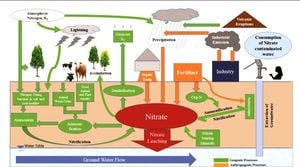Spain is currently experiencing severe weather conditions leading to the activation of various weather alerts by the Spanish State Meteorological Agency, known as AEMET. The weather agency has issued wide-ranging warnings due to the formation of another DANA, or Depresión Aislada en Niveles Altos, which results from the collision between cold and warm air masses. The onset of these meteorological conditions is expected to bring significant rainfall, especially to regions along the Mediterranean coast and the Balearic Islands.
Just weeks after the catastrophic flash floods hit Valencia, killing over 220 people and leaving dozens missing, people are urged to exercise caution. The new weather changes are likely to cause intense downpours which might trigger again the same kind of destructive flooding. AEMET has not just predicted rain but has expressed grave concerns about the potential risks involved with the anticipated conditions and has advised residents and tourists alike.
Warnings are currently being activated across major tourist zones such as Majorca, Valencia, and Alicante. Travelers are being warned with amber and yellow alerts indicating the severity of the situation. AEMET's amber alert indicates significant danger, implying the possibility of serious disruption due to extreme weather. Specific recommendations urge those residing or staying near dry ravines and gullies to avoid those areas during this period, as water levels can rise dramatically with little warning.
AEMET projected heavy rainfall throughout the day on November 12, with vast stretches of the Andalusian coast, particularly Malaga and its surroundings, expected to experience between 100 to 120mm of precipitation. This significant rainfall shows the potential to put additional strain on already stressed water reservoirs across the region.
Yet, it isn't just the rain that's causing concern; AEMET is also warning of the dangers of storms accompanying these heavy downpours. With anticipated rough sea conditions, individuals are advised against venturing near the coast until the alerts are lifted.
The AEMET is employing its color-coded system to identify levels of meteorological risk, which ranges from green (no risk) through yellow and orange (warnings of likelihood impacting daily activities) to red (severe risk). When the alert system is on red, it indicates extreme conditions, and AEMET recommends taking preventive measures such as abstaining from unnecessary travel and ensuring preparations are made at home and within communities.
To minimize risks associated with severe weather, 112 Andalucía, the local emergency service, has released several guidelines. These guidelines include advice such as avoiding parking vehicles near riverbeds—even if they appear dry—and verifying road conditions prior to travel. The importance of remaining updated with food forecasts and guidelines from authorities is also emphasized.
Making sure to steer clear of isolated areas during storms, where trees and rocks may attract lightning, is another consideration for personal safety, particularly for those involved or caught outside. Residents are also reminded to be vigilant on promenades or lookout points where sudden waves could pose of risk.
AEMET's detailed updates on the developing weather situation stress the significance of respecting the amber and yellow alerts. It sends the message loud and clear to the public: vigilance is key during these unpredictable times. The agency clearly states, "Do not approach dry ravines as they can quickly fill with water during sudden downpours." This reflects the serious attitude with which these weather alerts should be taken.
Should individuals find themselves caught amid floodwaters, AEMET advises rapid evacuation from the vehicle once the water rises above the wheel axle height. These guidelines are aimed not only at protecting life but also at averting future tragedies similar to those seen earlier this month.
The community’s trust also plays a pivotal role; relying swiftly on accurate information and updates from official sources is important for public safety. The call for action is loud and clear as individuals are encouraged not to share unverified information, thereby limiting the spread of misinformation during these emergencies.
AEMET's recent experiences shed light on the various challenges faced when assigning risk levels to weather phenomena. The complexity of forecasting these weather events poses questions not only for meteorologists but for individuals planning to travel or engage with nature during harsh weather conditions. The balance between awaiting forecasts and trusting agencies is delicate, but awareness and preparedness are becoming indispensable.
Looking back at the recent flooding, AEMET faced significant scrutiny over claims of insufficient warnings leading to tragedy. The accurate tracking of weather systems and real-time monitoring involves relying on multiple data points and resources. With storms and DANA phenomena being particularly complex to predict, models are heavily relied upon to ascertain upcoming weather scenarios.
Consequentially, any remnants of misunderstanding surrounding alert systems serve to highlight the importance of clear communication from official sources. The public should cultivate confidence not only when backlash arises but also when uncertainty looms.
The anticipated weather systems demonstrate nature’s relentless capabilities, which will undoubtedly continue to challenge communities' resilience as climate patterns remain unpredictable. While AEMET does its utmost to inform and advise, individual awareness and readiness become the foundation for personal safety and community well-being.
The latest updates by AEMET indicated improvements following the previous flooding scenario, with some sources noting the successful repair of monitoring tools. With these resources working effectively, improved forecasts are expected to prepare the population for severe weather adequately, avoiding past issues where warnings were inadequately communicated.
Tourists look forward to experiencing Spain’s vibrant culture and stunning landscapes, yet current weather advisories remain firmly placed, signaling the need for caution. Travelers heading to these affected areas—particularly those planning to enjoy outdoor leisure—should monitor AEMET for the latest updates and information. Observing local authorities' recommendations will also contribute to collective safety.
Spain is experiencing unpredictable weather, and caution is warranted. Although visitors are drawn to the country’s scenic beauty, they also need to remain cognizant of safety alerts and exercise vigilance. It’s no longer just about enjoying the sun and beaches but also about being informed about the potential risks posed by nature during this tumultuous weather period。



